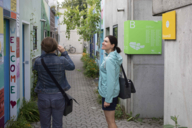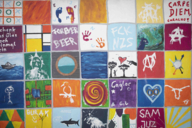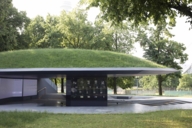
When Munich hosted the Summer Olympic Games of the XX Olympiad in 1972, the city’s concept for a sports quarter in a green area with short distances between venues and no cars proved a roaring success. The Olympic Village was constructed to accommodate the athletes attending the Games in apartments and bungalows, and it was within walking distance of the competition area. This group of listed buildings is a real hidden gem for architecture enthusiasts.
What started out as an experiment in urban development in the 1970s has become a proven approach which remains relevant today. After the Games were over, the former Men’s Olympic Village was transformed into a residential area, and the apartments and bungalows of the Women’s Village were rented out as student accommodation. A total of around 6,000 people live here. Just as the sports facilities in the Olympiapark (Olympic Park) are, the Olympic Village is ensconced in parkland which has been landscaped to resemble Alpine foothills.
Residents love the extensive green spaces, the neighbourly atmosphere and the good public transport connections with Munich city centre. Once you get settled here, you don’t want to leave: the Olympic Village is one of the most popular residential areas in Munich.
Painting is expressly permitted in the student village, and it’s well worth taking a stroll through the development to discover graffiti and artistic depictions of everyday student life adorning the bungalow façades.
Like any other village, everybody here knows everybody else. Local residents refer to themselves as the “Olympianer” and they get acquainted by meeting in shared community facilities such as the pub, club nights, café or film club. On sunny days, breakfast tables sometimes migrate out into the laneways – no cars disturb the peace of a morning enjoyed al fresco, as the area’s roads are all underground.

Media Lines, the colourful system of pipes running through the neighbourhood, was designed by Austrian architect Hans Hollein and provides lighting as well as a means of local guidance: blue stands for Connolystrasse, green for Nadistrasse, orange for Strassbergstrasse and yellow for the Helene-Mayer-Ring.
Spanning some 1.6 kilometres, the Lines extend throughout the entire Olympic Village and were originally used for securing speakers and awnings.

The Munich Olympic Games were tragically marred by an attack on the Israeli team in the Olympic Village. A plaque at number 31 Conollystraße commemorates the 5 September 1972 incident, which began with the taking of hostages and ended with the murder of all eleven Israeli hostages as well as a police officer.
Other articles that may interest you: The “Einschnitte” (“incisions”) memorial is a pavilion housing a multimedia display that commemorates the twelve victims of the 1972 Olympic massacre and outlines the historic background to the incident. The memorial space was officially opened in 2017 to mark the 45th anniversary of the hostage-taking, with relatives of the victims as well the Israeli and German heads of state in attendance. It can be easily reached on foot from the Olympic Village.